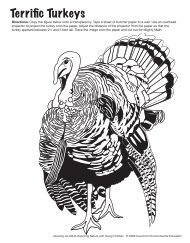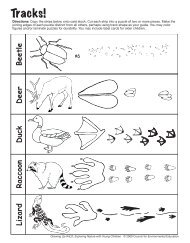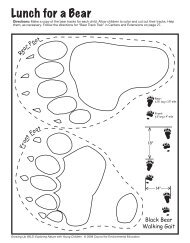Grades 5-8 - Project Wild
Grades 5-8 - Project Wild
Grades 5-8 - Project Wild
Create successful ePaper yourself
Turn your PDF publications into a flip-book with our unique Google optimized e-Paper software.
Guidelines for Environmental Education, <strong>Grades</strong> 5–8<br />
EXCELLENCE IN ENVIRONMENTAL EDUCATION:<br />
GUIDELINES FOR LEARNING, GRADES 5–8<br />
GUIDELINES FOR 5–8 TH GRADES<br />
Learners should be able to meet the guidelines included in this section by the end of eighth grade.<br />
In the fifth through eighth grades, learners begin to develop skills in abstract thinking and continue to<br />
develop creative thinking skills—and along with these, the ability to understand the interplay of<br />
environmental and human social systems in greater depth. Environmental education can foster this<br />
development by focusing on investigation of local environmental systems, problems, and issues. As learners<br />
become actively engaged in deciding for themselves what is right and wrong, educators can use<br />
environmental problems to help learners explore their own responsibilities and ethics.<br />
STRAND 1—QUESTIONING, ANALYSIS AND INTERPRETATION SKILLS<br />
A) Questioning—Learners are able to develop, focus, and explain questions that help them learn about the<br />
environment and do environmental investigations.<br />
¾ Identify environmental questions based on personal experiences both in and outside school, newspaper<br />
and magazine articles, television or radio news, or videos.<br />
¾ Summarize an environmental problem or situation to provide context for, or explain the origin of, a<br />
particular question. Create visual presentations (such as maps, graphs, or video tapes) and written and<br />
oral statements that describe their thinking about the problem.<br />
¾ Pose clear questions and ideas to test (hypotheses), reformulating them when necessary.<br />
¾ Clarify their own beliefs about the environment and discuss how those beliefs are reflected in the<br />
questions they ask.<br />
B) Designing investigations—Learners are able to design environmental investigations to answer particular<br />
questions—often their own questions.<br />
¾ Select types of inquiry appropriate to their questions.<br />
¾ Define the scope of their inquiry, identifying the main variables and phenomena to be studied.<br />
¾ Select appropriate systems of measurement and observation.<br />
¾ Select tools that are appropriate for their environmental investigations based on the question asked and<br />
the type of information sought.<br />
C) Collecting information—Learners are able to locate and collect reliable information about the<br />
environment or environmental topics using a variety of methods and sources.<br />
¾ Observe systematically, measure accurately, and keep thorough and accurate records, which may<br />
include written notes and data tables, sketches, and photographs.<br />
¾ Understand and use various systems of measurement and derived measurements such as rates.<br />
¾ Assess, choose, and synthesize materials from resources such as aerial photographs, topographic maps,<br />
and satellite images; library and museum collections, historical documents, and eyewitness accounts;<br />
computerized databases and spreadsheets; the internet; and government records.<br />
¾ Collect firsthand information about their own community using field study skills.<br />
D) Evaluating accuracy and reliability—Learners are able to judge the weaknesses and strengths of the<br />
information they are using.<br />
¾ Identify and evaluate vague claims they hear on television or through other media. For example,<br />
examine the credibility of results of public opinion polling about environmental topics, considering<br />
such factors as sampling methods, logical conclusions, and appropriate analogies.<br />
16
Guidelines for Environmental Education, <strong>Grades</strong> 5–8<br />
¾ Identify factors that affect the credibility of information, including assumptions and procedures used to<br />
create it; the social, political, and economic context in which the information was created; and<br />
potential bias due to omission, suppression, or invention of factual information.<br />
¾ Examine evidence, identify faulty reasoning, and apply other basic logic and reasoning skills in<br />
evaluating information sources.<br />
¾ Identify gaps in information that indicate a need for further discovery or inquiry.<br />
¾ Evaluate data and evidence for accuracy, relevance, significance, appropriateness, and clarity.<br />
E) Organizing information—Learners are able to classify and order data, and to organize and display<br />
information in ways that help analysis and interpretation.<br />
¾ Present environmental data in a variety of formats including charts, tables, plots, graphs, maps, and<br />
flow charts. For example, chart stream flows, create a map of local businesses that require air quality<br />
permits, or organize survey results into a table.<br />
¾ Explain why they chose specific ways of ordering and displaying information. Consider factors such as<br />
the question being answered, the type of information, and the purpose of the display.<br />
¾ Present environmental data in ways that demonstrate possible relationships between sets of information<br />
such as population census counts of a certain bird species and the prevalence of certain tree species or<br />
habitat types.<br />
F) Working with models and simulations—Learners understand many of the uses and limitations<br />
of models.<br />
¾ Describe how models are used to think about long-term processes such as population growth or<br />
processes that are difficult to see such as bird migration or the movement of the planets in relationship<br />
to the sun.<br />
¾ Use models to represent and investigate aspects of the physical world such as weather and specific<br />
phenomena such as hurricanes.<br />
¾ Manipulate mathematical and physical models using a computer.<br />
¾ Evaluate models based on the question being investigated. Account for variables such as the<br />
complexity of the model, its scale, its ability to represent important features of the process being<br />
modeled, and its reliability and accuracy.<br />
¾ Recognize limitations of models and simulations. For example, describe a situation in which a model<br />
of an environmental phenomenon is not useful.<br />
G) Drawing conclusions and developing explanations—Learners are able to synthesize their observations<br />
and findings into coherent explanations.<br />
¾ Distinguish between description and explanation and give examples of each based on their own<br />
environmental investigations.<br />
¾ Consider the possible relationships among two or more variables.<br />
¾ Propose explanations based on what they observed or learned through research, selecting which<br />
evidence to use and accounting for discrepancies. Synthesize and interpret information from a range of<br />
sources.<br />
¾ List strengths and weaknesses of proposed explanations. Discuss how the proposed explanation could<br />
be rejected or its reliability improved.<br />
¾ Use their proposed explanations to form new questions and suggest new avenues of inquiry.<br />
STRAND 2—KNOWLEDGE OF ENVIRONMENTAL PROCESSES AND SYSTEMS<br />
Strand 2.1—The Earth as a Physical System<br />
A) Processes that shape the Earth—Learners have a basic understanding of most of the physical processes<br />
that shape the Earth. They are able to explore the origin of differences in physical patterns.<br />
¾ Analyze physical patterns such as climate, areas of geothermal activity, soil types, and arid regions,<br />
suggesting reasons for these patterns. Explain these patterns in terms of abrupt forces (such as<br />
earthquakes or major storms) and long-term processes (such as erosion and rock formation), as well as<br />
those that are human-caused (such as suburban development or agricultural practices).<br />
17
Guidelines for Environmental Education, <strong>Grades</strong> 5–8<br />
¾ Predict the consequences of specific physical phenomena such as a hurricane in a coastal area or heavy<br />
grazing in an arid region.<br />
¾ Relate physical processes and patterns (such as climate, weather phenomena, and seasonal change) to<br />
the Earth/sun relationship. For example, create a model that shows how seasonal change is affected by<br />
the Earth/sun relationship.<br />
B) Changes in matter—Learners understand the properties of the substances that make up objects or<br />
materials found in the environment.<br />
¾ Describe a variety of chemical reactions and offer examples from daily life and the<br />
local environment.<br />
¾ Explain properties of materials in terms such as atomic and molecular structure or reactivity. For<br />
example, describe why particular building materials have properties such as rigidity, impermeability,<br />
or the ability to reflect or gather heat.<br />
¾ Explain an object’s characteristics based on its composition and how it was formed. For example,<br />
describe the characteristics of different types of rock and account for these characteristics based on<br />
their constituent parts and the processes by which they were formed.<br />
C) Energy—Learners begin to grasp formal concepts related to energy by focusing on energy transfer and<br />
transformations. They are able to make connections among phenomena such as light, heat, magnetism,<br />
electricity, and the motion of objects.<br />
¾ Trace the flow of energy in examples that encompass several different transfers and transformations of<br />
energy. For example, trace the path of energy in the creation and consumption of fossil fuels.<br />
¾ Explain how solar energy contributes to the movement of global air masses, the hydrological cycle and<br />
ocean currents.<br />
¾ Explain how the process of life is based on the conversion, utilization, storage and transfer of energy.<br />
For example, create a visual display that shows how plants or animals use energy, where that energy<br />
comes from, and where it goes.<br />
Strand 2.2—The Living Environment<br />
A) Organisms, populations, and communities—Learners understand that biotic communities are made up<br />
of plants and animals that are adapted to live in particular environments.<br />
¾ Define and give examples to illustrate the concepts of species, population, community,<br />
and ecosystem. Trace and give examples of connections among organisms at those levels<br />
of organization.<br />
¾ Link features of internal and external anatomy with the ability of organisms to make or find food and<br />
reproduce in particular environments.<br />
¾ Understand that some animals and plants have adapted to extreme environmental conditions. Give<br />
examples of adaptations that are behavioral (for example, the migration of Canada geese and other<br />
birds) and physical (such as the physical structures that enable desert animals and plants to exist on<br />
minimal amounts of water).<br />
¾ Describe how organisms differ in how they use energy. For example, identify organisms that use<br />
energy quickly for growth and metabolism, and therefore must replace it quickly (e.g., a hummingbird)<br />
and others that use energy more slowly and therefore need to replace it less frequently (e.g., a python).<br />
Predict the habitat needs of these different types of organisms.<br />
B) Heredity and evolution—Learners have a basic understanding of the importance of genetic heritage.<br />
¾ Describe some ways in which variation among individuals of the same species can sometimes give<br />
certain individuals an advantage within a specific environment.<br />
¾ Describe in general terms the theory of natural selection for particular traits and how that process can<br />
result in descendants that are quite different from their ancestors.<br />
¾ Define extinction, cite evidence of extinction, and identify some of its causes.<br />
¾ Discuss the possible implications of permanent loss of a species and how it affects interdependence<br />
within an ecosystem.<br />
18
Guidelines for Environmental Education, <strong>Grades</strong> 5–8<br />
C) Systems and connections. Learners understand major kinds of interactions among organisms or<br />
populations of organisms.<br />
¾ Describe and give examples of producer/consumer, predator/prey, and parasite/host relationships.<br />
¾ Identify organisms that are scavengers or decomposers. Describe the roles they play within particular<br />
systems focusing on their relationship to other organisms and physical elements of the system.<br />
¾ Summarize how abiotic and biotic components in combination influence the structure of an ecosystem.<br />
For example, create a map for the local region that shows average temperature and rainfall correlated<br />
with local forest, grassland or desert ecosystems. Or discuss the process of soil formation in terms of<br />
the interaction of climate, geology, and living organisms.<br />
D) Flow of matter and energy— Learners understand how energy and matter flows among the abiotic and<br />
biotic components of the environment.<br />
¾ Trace the flow of energy through food webs that identify relationships among organisms in natural<br />
systems.<br />
¾ Explain how matter is transferred among organisms and between organisms and their environment in<br />
these food webs.<br />
¾ Describe how energy, which enters ecosystems as sunlight, changes form and is transferred in the<br />
exchanges (production, consumption, and decomposition) that comprise food webs.<br />
Strand 2.3—Humans and Their Societies<br />
A) Individuals and groups—Learners understand that how individuals perceive the environment is<br />
influenced in part by individual traits and group membership or affiliation.<br />
¾ Describe individual development and identity in terms such as learning, perception, innate abilities,<br />
culture, social influences, and experience. Interpret their own beliefs about the environment using<br />
similar concepts.<br />
¾ Explain how group membership—and shared values, beliefs, and assumptions—can influence<br />
individuals, impel different reactions to physical and social environments and changes, and cause<br />
social change. For example, describe how family, religion, gender, ethnicity, socioeconomic status,<br />
and other factors may influence individuals’ values and perceptions about the environment and their<br />
communities.<br />
¾ Identify and critique instances of stereotyping based on group affiliation. For example, discuss how<br />
people who are all identified as “environmentalists” may have very different perspectives from one<br />
another.<br />
B) Culture—As they become familiar with a wider range of cultures and subcultures, learners gain an<br />
understanding of cultural perspectives on the environment and how the environment may, in turn, influence<br />
culture.<br />
¾ Explain how the environment is perceived differently by various cultures, and how these perspectives<br />
may influence individuals’ perceptions of the environment. For example, based on stories from other<br />
cultures, script and perform scenes about what is considered beautiful, valuable, or frightening in the<br />
environment.<br />
¾ Explain how new technologies can change cultural perceptions and social behavior. For example,<br />
discuss how snowmobiles have changed subsistence lifestyles in Alaska, or the impact of air<br />
conditioning on settlement in southern Florida.<br />
¾ Identify ways in which transportation and communications technology helps, or has helped, spread<br />
cultural values and behavior patterns.<br />
19
Guidelines for Environmental Education, <strong>Grades</strong> 5–8<br />
C) Political and economic systems—Learners become more familiar with political and economic systems<br />
and how these systems take the environment into consideration.<br />
¾ Differentiate among public and private goods and services, using environment-related goods and<br />
services to illustrate. For example, examine the values and functions of wetlands. Distinguish among<br />
public goods, such as groundwater recharge, flood control, and wildlife habitat; and private goods,<br />
such as their value for agricultural production or water storage, or the value of draining the land for<br />
other uses. Discuss difficulties encountered in drawing these distinctions.<br />
¾ Identify economic and political features of the local community and state, and describe how<br />
environmental decisions can be influenced by these economic and political systems and actors.<br />
¾ Identify ways in which governments and economic systems work to protect the environment and<br />
distribute natural resources. Give examples of laws, incentives, and penalties that affect people’s<br />
behavior toward the environment and each other.<br />
D) Global connections—Learners become familiar with ways in which the world’s environmental, social,<br />
economic, cultural, and political systems are linked.<br />
¾ Explain international trade in terms of uneven distribution of resources.<br />
¾ Describe ways in which the global environment is affected by individual and group actions, as well as<br />
by government policies and actions having to do with energy use and other forms of consumption,<br />
waste disposal, resource management, industry, and population.<br />
¾ Explain how an environmental change in one part of the world can have consequences for other places.<br />
For example, develop a map or another visual presentation that shows the effects of acid rain or<br />
nuclear fallout in places distant from the source of the pollution.<br />
¾ Identify a variety of global links, including transportation and communication systems, treaties, multinational<br />
corporations, and international organizations.<br />
E) Change and conflict—Learners understand that human systems change over time and that conflicts<br />
sometimes arise over differing and changing viewpoints about the environment.<br />
¾ Describe patterns of change within and across cultures, communities, and other groups.<br />
Consider the rapidity of change, mechanisms that helped spread change, and what motivated change.<br />
For example, discuss how and why wastewater treatment became a common practice in the United<br />
States.<br />
¾ Explain how change affects individuals and groups differently and give examples of the trade-offs<br />
involved in decisions and actions ranging from the individual to the societal levels. For example,<br />
discuss how a decision about where to site a landfill, build a chemical plant, or locate a new highway<br />
might affect different neighborhoods, businesses, workers, people of varying socio-economic status,<br />
and others. Role play their reactions.<br />
¾ Describe and analyze examples of tensions between individual rights and benefits and the societal<br />
good. Illustrate with examples from the local community, possibly including disagreements over<br />
zoning, controversial proposals to raise taxes to pay for the purchase of open space or sewer system<br />
upgrades, or tradeoffs between commuting to work individually in a car or taking public<br />
transportation.<br />
¾ Identify some of the formal and informal ways that groups (including governments) attempt to<br />
anticipate, avoid, or resolve conflicts related to the environment.<br />
Strand 2.4—Environment and Society<br />
A) Human/environment interactions— Learners understand that human-caused changes have consequences<br />
for the immediate environment as well as for other places and future times.<br />
¾ Describe intended and unintended environmental and social consequences associated with the<br />
changing use of technologies. Consider consequences that may be positive as well as negative. For<br />
example, discuss particular irrigation methods, different ways of generating electrical power, or the<br />
use of synthetic pesticides.<br />
¾ Explain how human-caused environmental changes cause changes in other places. For example,<br />
discuss the effects of building a dam on downstream plant and animal communities as well as on<br />
human communities.<br />
20
Guidelines for Environmental Education, <strong>Grades</strong> 5–8<br />
¾ Describe the effects of a local environmental restoration effort, such as wetlands creation. Predict the<br />
long-term consequences of such efforts, or a particular restoration project.<br />
B) Places—Learners begin to explore the meaning of places both close to home and around the world.<br />
¾ Analyze physical and human characteristics of places and make inferences about how and why these<br />
characteristics have developed and changed over time. For example, use maps and satellite<br />
photographs to examine how cities change in response to natural disasters such as floods, hurricanes,<br />
or earthquakes.<br />
¾ Identify ways in which personal perceptions, culture, and technology influence people’s perceptions of<br />
places. Discuss the importance of some places (such as Yellowstone National Park or the Mississippi<br />
River) as cultural symbols.<br />
¾ Identify regions based on different criteria such as watershed boundaries, sales and service areas for<br />
different businesses, or the area from which sports teams draw fans or symphony orchestras attract<br />
audiences.<br />
C) Resources—Learners understand that uneven distribution of resources influences their use and perceived<br />
value.<br />
¾ Map and discuss distribution and consumption patterns for specific resources, such as metals, fresh<br />
water, or certain types of forests. Note resources that are being rapidly depleted.<br />
¾ Explain why certain resources (such as oil, coal, or natural gas) are key to the development of human<br />
societies, and identify resources that were critical to development at different times in history.<br />
¾ Explain conflicts between individuals, states, regions, or nations noting factors such as differing attitudes<br />
about the use of specific resources and scarcity of natural resources. Illustrate with local or regional<br />
examples such as conflicts over water rights and use of habitat for local endangered species.<br />
D) Technology—Learners understand the human ability to shape and control the environment as a function<br />
of the capacities for creating knowledge and developing new technologies.<br />
¾ Discuss technologies in the context of larger systems that have shaped the course of human history as<br />
well as human relationships with the environment. Use illustrations from the agricultural, industrial<br />
and transportation revolutions that have dramatically changed how people live and use resources.<br />
¾ Analyze how the ability to develop and use technology gives humans great influence over the<br />
environment and other living things. Use examples from their region, such as the ability to construct<br />
levees to protect areas from flooding or create wildlife refuges, build machines that produce or reduce<br />
air or water pollution, or domesticate plants or animals for food production.<br />
¾ Identify some of the important environmental and social issues related to particular technological<br />
developments in fields such as agriculture, manufacturing, and energy.<br />
E) Environmental issues—Learners are familiar with a range of environmental issues at scales that range<br />
from local to national to global. They understand that people in other places around the world experience<br />
issues similar to the ones they are concerned about locally.<br />
¾ Identify other places, either contemporary or historical, experiencing issues similar to those in the<br />
learner’s community or region.<br />
¾ Explain how issues arise because of conflicting points of view about a specific proposal, event, or<br />
condition in the environment. For example, discuss conflicting perspectives about past and present<br />
proposals to build large-scale dams such as the Three Gorges project in China, the Hetch-Hetchy dam<br />
in the U.S., or a similar project in the learner’s region.<br />
¾ Discuss how the disagreements at the heart of environmental issues make them difficult to resolve.<br />
Consider the role of understanding, creativity, or compromise in finding solutions.<br />
21
Guidelines for Environmental Education, <strong>Grades</strong> 5–8<br />
STRAND 3—SKILLS FOR UNDERSTANDING AND ADDRESSING<br />
ENVIRONMENTAL ISSUES<br />
Strand 3.1—Skills for Analyzing and Investigating Environmental Issues<br />
A) Identifying and investigating issues—Learners are able to use primary and secondary sources of<br />
information, and apply growing research and analytical skills, to investigate environmental issues, beginning<br />
in their own community.<br />
¾ Clearly articulate and define environmental issues. For example, describe the history and origins of the<br />
issue, actions that have been taken to address the issue, the apparent effects of these actions, and the<br />
current situation.<br />
¾ Identify key individuals and groups involved, their viewpoints, and the types of action they support.<br />
Describe areas of conflict and agreement.<br />
¾ Investigate the issue using secondary sources and original research where needed.<br />
¾ Examine how others have analyzed and understood the issue, identifying their approaches and the<br />
assumptions behind them.<br />
¾ Compare the issue with similar issues from other places and times.<br />
B) Sorting out the consequences of issues—Learners are able to apply their knowledge of ecological and<br />
human processes and systems to identify the consequences of specific environmental issues.<br />
¾ Describe the effects of human actions on specific elements, systems, and processes of<br />
the environment.<br />
¾ Analyze issues by looking at trade-offs that have been made. For example, consider where various<br />
human activities (such as landfills, highways, chemical factories, or hazardous waste incinerators) are<br />
located and their effects on different places and different segments of the population.<br />
¾ Speculate about the effects of a proposed state or local environmental regulation. For example,<br />
consider effects on different sectors of the economy, neighborhoods, public health, particular plant and<br />
animal species and communities, and overall environmental quality.<br />
¾ <strong>Project</strong> the consequences of inaction or failure to resolve particular issues.<br />
C) Identifying and evaluating alternative solutions and courses of action—Learners are able to identify<br />
and develop action strategies for addressing particular issues.<br />
¾ Identify different proposals for resolving an environmental issue. Recognize and explain the<br />
perspectives on the issue that are embedded in those views.<br />
¾ Explain why various strategies may be effective in different situations. Consider their likely effects on<br />
society and the environment.<br />
¾ Independently and in groups, develop original strategies to address issues.<br />
¾ Discern similarities and differences in problem situations which might affect their ability to apply<br />
strategies that were successful in other places and times.<br />
D) Working with flexibility, creativity, and openness—Learners are able to consider the assumptions and<br />
interpretations that influence the conclusions they and others draw about environmental issues.<br />
¾ Explain how the interplay of ideas and perspectives strengthens the process of inquiry and the societal<br />
ability to address issues.<br />
¾ Receive questions and alternative explanations that others offer in discussions as well as in readings.<br />
¾ Explain why it is not always possible to select one correct explanation or a single best approach to<br />
addressing an issue.<br />
Strand 3.2—Decision-Making and Citizenship Skills<br />
A) Forming and evaluating personal views—Learners are able to identify, justify, and clarify their views on<br />
environmental issues and alternative ways to address them.<br />
¾ Discuss personal perspectives with classmates, remaining open to new ideas and information.<br />
¾ Justify their views based on information from a variety of sources, and clear reasoning.<br />
22
Guidelines for Environmental Education, <strong>Grades</strong> 5–8<br />
¾ Discuss their own beliefs and values regarding the environment and relate their personal view of<br />
environmental issues to these.<br />
¾ Identify ways in which others’ views correspond or differ with their own views.<br />
B) Evaluating the need for citizen action—Learners are able to evaluate whether they believe action is<br />
needed in particular situations, and decide whether they should be involved.<br />
¾ Discuss whether action is warranted. Account for factors such as the scale of the problem; legal, social,<br />
economic, and ecological consequences; and alternatives to citizen action.<br />
¾ Identify different forms of action that citizens can take in the economic, political, and legal spheres, as<br />
well as actions aimed at directly improving or maintaining some part of the environment or persuading<br />
others to take action.<br />
¾ Speculate about the likely effects of specific actions on society and the environment, and the likelihood<br />
these actions will resolve a specific environmental issue.<br />
¾ Point out advantages and disadvantages of their personal involvement, considering factors such as their<br />
own skills, resources, knowledge, and commitment.<br />
C) Planning and taking action—As learners begin to see themselves as citizens taking active roles in their<br />
communities, they are able to plan for and engage in citizen action at levels appropriate to their maturity and<br />
preparation.<br />
¾ Develop action plans they can carry out individually, in small groups, or with a class, club, or larger<br />
organization. Include clear reasons and goals for action. Base these plans on knowledge of a range of<br />
citizen action strategies and the results of their environmental issue investigations.<br />
¾ Set realistic goals for action and include measures of success consistent with learners’ abilities and an<br />
understanding of the complexity of the issue.<br />
¾ Decide whether their plan should be implemented immediately or at another time, changed, or<br />
abandoned; and carry through with action when appropriate.<br />
D) Evaluating the results of actions—Learners are able to analyze the effects of their own actions and<br />
actions taken by other individuals and groups.<br />
¾ Analyze the effects of decisions, policies, and actions taken by individuals and groups on a particular<br />
issue.<br />
¾ Analyze their own actions, explaining apparent effects and discussing them in light of students’ goals<br />
and reasons for acting.<br />
¾ Describe some of the reasons why analyzing the results of actions may be difficult, including the scale<br />
of the issue, the time required to see effects, and the influence of other actions and factors.<br />
STRAND 4—PERSONAL AND CIVIC RESPONSIBILITY<br />
A) Understanding societal values and principles—Learners understand that societal values can be both a<br />
unifying and a divisive force.<br />
¾ Identify some of the shared political values and principles that unite American society, and explain<br />
their importance.<br />
¾ Discuss conflicting views about the meaning and application of shared values in specific issues. For<br />
example, explore conflicting views about the idea that one person’s rights end where they infringe on<br />
another’s. Use a specific context such as proposed sports stadium or whether to permit an industrial<br />
facility or housing development that is likely to pollute a stream.<br />
¾ Identify ways in which advocates appeal to values such as individual freedoms, property rights, the<br />
public good, economic well-being, and patriotism. For example, analyze speeches and writing on<br />
specific environmental issues.<br />
¾ Evaluate the principle of stewardship as a shared societal value. For example, compare conceptions of<br />
stewardship contained in writings of John Muir, Gifford Pinchot, and Aldo Leopold with their own<br />
understanding.<br />
23
Guidelines for Environmental Education, <strong>Grades</strong> 5–8<br />
B) Recognizing citizens’ rights and responsibilities—Learners understand the rights and responsibilities of<br />
citizenship and their importance in promoting the resolution of environmental issues.<br />
¾ Identify rights and responsibilities associated with citizenship, including personal and civic<br />
responsibilities.<br />
¾ Describe ways in which commonly accepted rights and responsibilities of citizenship motivate people<br />
to help resolve environmental issues. Consider rights and responsibilities such as acquiring, using and<br />
selling property; the right to vote; freedom of speech and assembly; accepting responsibility for the<br />
consequences of one’s actions; obeying the law; and respecting the rights and interests of others.<br />
C) Recognizing efficacy—Learners possess a realistic self-confidence in their effectiveness as citizens.<br />
¾ Explain the ways in which citizen action and public opinion influence environmental policy decisions.<br />
¾ Describe how individuals and groups act within society to create change, meet individual needs and<br />
promote the common good. Illustrate with examples from environmental issues.<br />
¾ Describe ways in which their actions have made a difference. Use examples that begin in the classroom<br />
and the home, and extend beyond to encompass the broader communities in which students begin to<br />
see possibilities for action.<br />
D) Accepting personal responsibility—Learners understand that their actions can have broad consequences<br />
and that they are responsible for those consequences.<br />
¾ Analyze some of the effects that their actions (and the actions of their families, social groups, and<br />
communities) have on the environment, other humans, and other living beings.<br />
¾ Describe actions in terms of their effects that reach into the future.<br />
¾ Describe their personal responsibilities, comparing their view of their responsibilities with commonly<br />
accepted societal views.<br />
¾ Identify ways in which they feel responsible for helping resolve environmental issues within their<br />
community.<br />
24
<strong>Project</strong> WILD Correlation to Environmental Education Guidelines, <strong>Grades</strong> 5–8<br />
Key to Symbols:<br />
˜ The EE concept is the main focus of<br />
the <strong>Project</strong> WILD activity.<br />
• The concept is one of the main focuses<br />
of the activity; is reinforced.<br />
š The concept is not the main focus of the<br />
activity, but it is supported or reinforced.<br />
ENVIRONMENTAL EDUCATION<br />
GUIDELINES FOR LEARNING, 5–8<br />
Interview a Spider<br />
(gr. 5–8, p. 12)<br />
Habitat Rummy<br />
(gr. 5–8, p. 14)<br />
Bearly Growing<br />
(gr. 5–8, p. 19)<br />
How Many Bears Can Live<br />
in This Forest (gr. 5–8, p. 23)<br />
My Kingdom for a Shelter<br />
(gr. 5–8, p. 28)<br />
Tracks! (gr. 5–8, p. 30)<br />
Spider Web Geometry<br />
(gr. 5–8, p. 34)<br />
Oh Deer! (gr. 5–8, p. 36)<br />
<strong>Wild</strong> Words (gr. 5–8, p. 41)<br />
Habitat Lap Sit<br />
(gr. 5–8, p. 61)<br />
Who Fits Here<br />
(gr. 5–8, p. 64)<br />
Which Niche<br />
(gr. 5–8, p. 66)<br />
What Did Your Lunch Cost<br />
<strong>Wild</strong>life (gr. 5–8, p. 68)<br />
STRAND 1—QUESTIONING AND<br />
ANALYSIS SKILLS<br />
A. Questioning ˜<br />
B. Designing investigations ˜ š š š š š<br />
C. Collecting information ˜ • š • • š š • • •<br />
D. Evaluating accuracy and reliability š<br />
E. Organizing information • • • š š š • š š<br />
F. Working with models and simulations • • • • •<br />
G. Developing explanations š š • š š š š š š •<br />
STRAND 2—KNOWLEDGE OF<br />
ENVIRONMENTAL PROCESSES<br />
AND SYSTEMS<br />
2.1—The Earth as a Physical System<br />
A. Processes that shape the Earth<br />
B. Changes in matter<br />
C. Energy š<br />
2.2—The Living Environment<br />
A. Organisms, populations, and communities š ˜ š ˜ š š ˜ • ˜ ˜ š<br />
B. Heredity and evolution š • • š •<br />
C. Systems and connections ˜ • ˜ š ˜ ˜<br />
D. Flow of matter and energy • • š š • š<br />
2.3—Humans and Their Societies<br />
A. Individuals and groups<br />
B. Culture<br />
C. Political and economic systems<br />
D. Global connections š<br />
E. Change and conflict<br />
2.4—Environment and Society<br />
A. Human/environment interactions š š<br />
B. Places<br />
C. Resources š<br />
D. Technology<br />
E. Environmental issues<br />
25
<strong>Project</strong> WILD Correlation to Environmental Education Guidelines, <strong>Grades</strong> 5–8<br />
Key to Symbols:<br />
˜ The EE concept is the main focus of<br />
the <strong>Project</strong> WILD activity.<br />
• The concept is one of the main focuses<br />
of the activity; is reinforced.<br />
š The concept is not the main focus of the<br />
activity, but it is supported or reinforced.<br />
ENVIRONMENTAL EDUCATION<br />
GUIDELINES FOR LEARNING, 5–8<br />
Interview a Spider<br />
(gr. 5–8, p. 12)<br />
Habitat Rummy<br />
(gr. 5–8, p. 14)<br />
Bearly Growing<br />
(gr. 5–8, p. 19)<br />
How Many Bears Can Live<br />
in This Forest (gr. 5–8, p. 23)<br />
My Kingdom for a Shelter<br />
(gr. 5–8, p. 28)<br />
Tracks! (gr. 5–8, p. 30)<br />
Spider Web Geometry<br />
(gr. 5–8, p. 34)<br />
Oh Deer! (gr. 5–8, p. 36)<br />
<strong>Wild</strong> Words (gr. 5–8, p. 41)<br />
Habitat Lap Sit<br />
(gr. 5–8, p. 61)<br />
Who Fits Here<br />
(gr. 5–8, p. 64)<br />
Which Niche<br />
(gr. 5–8, p. 66)<br />
What Did Your Lunch Cost<br />
<strong>Wild</strong>life (gr. 5–8, p. 68)<br />
STRAND 3—SKILLS FOR<br />
UNDERSTANDING AND ADDRESSING<br />
ENVIRONMENTAL ISSUES<br />
3.1—Skills for Analyzing and<br />
Investigating Environmental Issues<br />
A. Identifying and investigating issues š<br />
B. Sorting out the consequences of issues š<br />
C. Identifying and evaluating alternative<br />
š<br />
solutions and courses of action<br />
D. Working with flexibility, creativity,<br />
š<br />
and openness<br />
3.2—Decision-Making and<br />
Citizenship Skills<br />
A. Forming and evaluating personal views š<br />
B. Evaluating the need for citizen action<br />
C. Planning and taking action<br />
D. Evaluating the results of actions š<br />
STRAND 4—PERSONAL AND CIVIC<br />
RESPONSIBILITY<br />
A. Understanding societal values and<br />
principles<br />
B. Recognizing citizens’ rights and<br />
responsibilities<br />
C. Recognizing efficacy<br />
D. Accepting personal responsibility š<br />
26
<strong>Project</strong> WILD Correlation to Environmental Education Guidelines, <strong>Grades</strong> 5–8<br />
Key to Symbols:<br />
˜ The EE concept is the main focus of<br />
the <strong>Project</strong> WILD activity.<br />
• The concept is one of the main focuses<br />
of the activity; is reinforced.<br />
š The concept is not the main focus of the<br />
activity, but it is supported or reinforced.<br />
ENVIRONMENTAL EDUCATION<br />
GUIDELINES FOR LEARNING, 5–8<br />
Urban Nature Search<br />
(gr. 5–8, p. 70)<br />
Rainfall and the Forest<br />
(gr. 5–8, p. 73)<br />
Microtrek Treasure Hunt<br />
(gr. 5–8, p. 82)<br />
Stormy Weather<br />
(gr. 5–8, p. 85)<br />
Ants on a Twig<br />
(gr. 5–8, p. 88)<br />
Good Buddies<br />
(gr. 5–8, p. 91)<br />
What’s for Dinner<br />
(gr. 5–8, p. 96)<br />
Seed Need (gr. 5–8, p. 98)<br />
Owl Pellets (gr. 5–8, p. 100)<br />
Eco-Enrichers<br />
(gr. 5–8, p. 102)<br />
Energy Pipeline<br />
gr. 7–8, p. 105)<br />
Quick-Frozen Critters<br />
(gr. 5–8, p. 122)<br />
Polar Bears in Phoenix<br />
(gr. 5–8, p. 125)<br />
STRAND 1—QUESTIONING AND<br />
ANALYSIS SKILLS<br />
A. Questioning<br />
B. Designing investigations š š š š š š<br />
C. Collecting information • • • • š š š • • • • •<br />
D. Evaluating accuracy and reliability š<br />
E. Organizing information š ˜ • • š š • • • •<br />
F. Working with models and simulations • • š š š ˜ ˜ •<br />
G. Developing explanations š • š • š š š š • • • •<br />
STRAND 2—KNOWLEDGE OF<br />
ENVIRONMENTAL PROCESSES<br />
AND SYSTEMS<br />
2.1—The Earth as a Physical System<br />
A. Processes that shape the Earth š š<br />
B. Changes in matter<br />
C. Energy • ˜<br />
2.2—The Living Environment<br />
A. Organisms, populations, and communities • • š • š š š š š • š<br />
B. Heredity and evolution<br />
C. Systems and connections š • š š • š š • • • • š<br />
D. Flow of matter and energy š ˜ š • š ˜ š<br />
2.3—Humans and Their Societies<br />
A. Individuals and groups<br />
B. Culture<br />
C. Political and economic systems<br />
D. Global connections š<br />
E. Change and conflict<br />
2.4—Environment and Society<br />
A. Human/environment interactions š š š<br />
B. Places<br />
C. Resources š<br />
D. Technology<br />
E. Environmental issues<br />
27
<strong>Project</strong> WILD Correlation to Environmental Education Guidelines, <strong>Grades</strong> 5–8<br />
Key to Symbols:<br />
˜ The EE concept is the main focus of<br />
the <strong>Project</strong> WILD activity.<br />
• The concept is one of the main focuses<br />
of the activity; is reinforced.<br />
š The concept is not the main focus of the<br />
activity, but it is supported or reinforced.<br />
ENVIRONMENTAL EDUCATION<br />
GUIDELINES FOR LEARNING, 5–8<br />
Urban Nature Search<br />
(gr. 5–8, p. 70)<br />
Rainfall and the Forest<br />
(gr. 5–8, p. 73)<br />
Microtrek Treasure Hunt<br />
(gr. 5–8, p. 82)<br />
Stormy Weather<br />
(gr. 5–8, p. 85)<br />
Ants on a Twig<br />
(gr. 5–8, p. 88)<br />
Good Buddies<br />
(gr. 5–8, p. 91)<br />
What’s for Dinner<br />
(gr. 5–8, p. 96)<br />
Seed Need (gr. 5–8, p. 98)<br />
Owl Pellets (gr. 5–8, p. 100)<br />
Eco-Enrichers<br />
(gr. 5–8, p. 102)<br />
Energy Pipeline<br />
gr. 7–8, p. 105)<br />
Quick-Frozen Critters<br />
(gr. 5–8, p. 122)<br />
Polar Bears in Phoenix<br />
(gr. 5–8, p. 125)<br />
STRAND 3—SKILLS FOR<br />
UNDERSTANDING AND ADDRESSING<br />
ENVIRONMENTAL ISSUES<br />
3.1—Skills for Analyzing and<br />
Investigating Environmental Issues<br />
A. Identifying and investigating issues<br />
B. Sorting out the consequences of issues<br />
C. Identifying and evaluating alternative<br />
solutions and courses of action<br />
D. Working with flexibility, creativity,<br />
and openness<br />
3.2—Decision-Making and<br />
Citizenship Skills<br />
A. Forming and evaluating personal views š<br />
B. Evaluating the need for citizen action<br />
C. Planning and taking action<br />
D. Evaluating the results of actions<br />
STRAND 4—PERSONAL AND CIVIC<br />
RESPONSIBILITY<br />
A. Understanding societal values and<br />
principles<br />
B. Recognizing citizens’ rights and<br />
responsibilities<br />
C. Recognizing efficacy š š<br />
D. Accepting personal responsibility š š<br />
28
<strong>Project</strong> WILD Correlation to Environmental Education Guidelines, <strong>Grades</strong> 5–8<br />
Key to Symbols:<br />
˜ The EE concept is the main focus of<br />
the <strong>Project</strong> WILD activity.<br />
• The concept is one of the main focuses<br />
of the activity; is reinforced.<br />
š The concept is not the main focus of the<br />
activity, but it is supported or reinforced.<br />
ENVIRONMENTAL EDUCATION<br />
GUIDELINES FOR LEARNING, 5–8<br />
Adaptation Artistry<br />
(gr. 5–8, p. 128)<br />
Muskox Maneuvers<br />
(gr. 5–8, p. 130)<br />
I’m Thirsty (gr. 6–8, p. 134)<br />
Move Over Rover<br />
(gr. 5–6, p. 144)<br />
Planting Animals<br />
(gr. 5–8, p. 152)<br />
Here Today, Gone<br />
Tomorrow (gr. 5–8, p. 154)<br />
Time Lapse (gr. 5–8, p. 158)<br />
Ecosystem Facelift<br />
(gr. 7–8, p. 166)<br />
Museum Search for <strong>Wild</strong>life<br />
(gr. 5–8, p. 182)<br />
Saturday Morning <strong>Wild</strong>life<br />
Watching (gr. 5–8, p. 184)<br />
<strong>Wild</strong>life in National<br />
Symbols (gr. 5–8, p. 186)<br />
Prairie Memoirs<br />
(gr. 5–8, p. 188)<br />
Cartoons and Bumper<br />
Stickers (gr. 5–8, p. 192)<br />
STRAND 1—QUESTIONING AND<br />
ANALYSIS SKILLS<br />
A. Questioning ˜ • š š<br />
B. Designing investigations š š<br />
C. Collecting information š š • • • ˜ š š • š<br />
D. Evaluating accuracy and reliability š<br />
E. Organizing information š š • • • ˜ ˜ š<br />
F. Working with models and simulations š ˜ š ˜ • • ˜<br />
G. Developing explanations š • • • • • ˜ •<br />
STRAND 2—KNOWLEDGE OF<br />
ENVIRONMENTAL PROCESSES<br />
AND SYSTEMS<br />
2.1—The Earth as a Physical System<br />
A. Processes that shape the Earth •<br />
B. Changes in matter š<br />
C. Energy š<br />
2.2—The Living Environment<br />
A. Organisms, populations, and communities ˜ ˜ • ˜ š •<br />
B. Heredity and evolution • š ˜ • ˜ š<br />
C. Systems and connections ˜ š ˜ š š š •<br />
D. Flow of matter and energy š š š<br />
2.3—Humans and Their Societies<br />
A. Individuals and groups š<br />
B. Culture š š ˜ š<br />
C. Political and economic systems<br />
D. Global connections<br />
E. Change and conflict<br />
2.4—Environment and Society<br />
A. Human/environment interactions š š š š š<br />
B. Places<br />
C. Resources š š<br />
D. Technology š<br />
E. Environmental issues<br />
29
<strong>Project</strong> WILD Correlation to Environmental Education Guidelines, <strong>Grades</strong> 5–8<br />
Key to Symbols:<br />
˜ The EE concept is the main focus of<br />
the <strong>Project</strong> WILD activity.<br />
• The concept is one of the main focuses<br />
of the activity; is reinforced.<br />
š The concept is not the main focus of the<br />
activity, but it is supported or reinforced.<br />
ENVIRONMENTAL EDUCATION<br />
GUIDELINES FOR LEARNING, 5–8<br />
Adaptation Artistry<br />
(gr. 5–8, p. 128)<br />
Muskox Maneuvers<br />
(gr. 5–8, p. 130)<br />
I’m Thirsty (gr. 6–8, p. 134)<br />
Move Over Rover<br />
(gr. 5–6, p. 144)<br />
Planting Animals<br />
(gr. 5–8, p. 152)<br />
Here Today, Gone<br />
Tomorrow (gr. 5–8, p. 154)<br />
Time Lapse (gr. 5–8, p. 158)<br />
Ecosystem Facelift<br />
(gr. 7–8, p. 166)<br />
Museum Search for <strong>Wild</strong>life<br />
(gr. 5–8, p. 182)<br />
Saturday Morning <strong>Wild</strong>life<br />
Watching (gr. 5–8, p. 184)<br />
<strong>Wild</strong>life in National<br />
Symbols (gr. 5–8, p. 186)<br />
Prairie Memoirs<br />
(gr. 5–8, p. 188)<br />
Cartoons and Bumper<br />
Stickers (gr. 5–8, p. 192)<br />
STRAND 3—SKILLS FOR<br />
UNDERSTANDING AND ADDRESSING<br />
ENVIRONMENTAL ISSUES<br />
3.1—Skills for Analyzing and<br />
Investigating Environmental Issues<br />
A. Identifying and investigating issues š<br />
B. Sorting out the consequences of issues<br />
C. Identifying and evaluating alternative<br />
solutions and courses of action<br />
D. Working with flexibility, creativity,<br />
š<br />
and openness<br />
3.2—Decision-Making and<br />
Citizenship Skills<br />
A. Forming and evaluating personal views š<br />
B. Evaluating the need for citizen action<br />
C. Planning and taking action<br />
D. Evaluating the results of actions š<br />
STRAND 4—PERSONAL AND CIVIC<br />
RESPONSIBILITY<br />
A. Understanding societal values and<br />
principles<br />
B. Recognizing citizens’ rights and<br />
responsibilities<br />
C. Recognizing efficacy<br />
D. Accepting personal responsibility<br />
•<br />
30
<strong>Project</strong> WILD Correlation to Environmental Education Guidelines, <strong>Grades</strong> 5–8<br />
Key to Symbols:<br />
˜ The EE concept is the main focus of<br />
the <strong>Project</strong> WILD activity.<br />
• The concept is one of the main focuses<br />
of the activity; is reinforced.<br />
š The concept is not the main focus of the<br />
activity, but it is supported or reinforced.<br />
ENVIRONMENTAL EDUCATION<br />
GUIDELINES FOR LEARNING, 5–8<br />
Power of a Song<br />
(gr. 5–8, p. 194)<br />
For Your Eyes Only<br />
(gr. 5–8, p. 197)<br />
Ethi-Reasoning<br />
(gr. 5–8, p. 203)<br />
What You Wear is What<br />
They Were (gr. 5–8, p. 210)<br />
Does <strong>Wild</strong>life Sell<br />
(gr. 5–8, p. 213)<br />
Pay to Play (gr. 5–8, p. 216)<br />
Lobster in Your Lunch Box<br />
(gr. 5–8, p. 245)<br />
Let’s Talk Turkey<br />
(gr. 5–8, p. 248)<br />
<strong>Wild</strong>life Bibliography<br />
(gr. 5–8, p. 253)<br />
Changing Attitudes<br />
(gr. 5–8, p. 255)<br />
Changing Societies<br />
(gr. 7–8, p. 258)<br />
History of <strong>Wild</strong>life<br />
Management (gr. 5–8, p. 267)<br />
Animal Poetry<br />
(gr. 5–8, p. 282)<br />
STRAND 1—QUESTIONING AND<br />
ANALYSIS SKILLS<br />
A. Questioning •<br />
B. Designing investigations •<br />
C. Collecting information š š š • š š<br />
D. Evaluating accuracy and reliability ˜<br />
E. Organizing information š š š<br />
F. Working with models and simulations • š š<br />
G. Developing explanations š š š š<br />
STRAND 2—KNOWLEDGE OF<br />
ENVIRONMENTAL PROCESSES<br />
AND SYSTEMS<br />
2.1—The Earth as a Physical System<br />
A. Processes that shape the Earth<br />
B. Changes in matter<br />
C. Energy<br />
2.2—The Living Environment<br />
A. Organisms, populations, and communities š š<br />
B. Heredity and evolution š<br />
C. Systems and connections š •<br />
D. Flow of matter and energy •<br />
2.3—Humans and Their Societies<br />
A. Individuals and groups š ˜ š š š š • š<br />
B. Culture š • š š š š • š<br />
C. Political and economic systems • ˜ š š<br />
D. Global connections • š<br />
E. Change and conflict š š š<br />
2.4—Environment and Society<br />
A. Human/environment interactions • • • š •<br />
B. Places ˜ š š š<br />
C. Resources š • • š š š<br />
D. Technology<br />
E. Environmental issues š •<br />
31
<strong>Project</strong> WILD Correlation to Environmental Education Guidelines, <strong>Grades</strong> 5–8<br />
Key to Symbols:<br />
˜ The EE concept is the main focus of<br />
the <strong>Project</strong> WILD activity.<br />
• The concept is one of the main focuses<br />
of the activity; is reinforced.<br />
š The concept is not the main focus of the<br />
activity, but it is supported or reinforced.<br />
ENVIRONMENTAL EDUCATION<br />
GUIDELINES FOR LEARNING, 5–8<br />
STRAND 3—SKILLS FOR<br />
UNDERSTANDING AND ADDRESSING<br />
ENVIRONMENTAL ISSUES<br />
Power of a Song<br />
(gr. 5–8, p. 194)<br />
For Your Eyes Only<br />
(gr. 5–8, p. 197)<br />
Ethi-Reasoning<br />
(gr. 5–8, p. 203)<br />
What You Wear is What<br />
They Were (gr. 5–8, p. 210)<br />
Does <strong>Wild</strong>life Sell<br />
(gr. 5–8, p. 213)<br />
Pay to Play (gr. 5–8, p. 216)<br />
Lobster in Your Lunch Box<br />
(gr. 5–8, p. 245)<br />
Let’s Talk Turkey<br />
(gr. 5–8, p. 248)<br />
<strong>Wild</strong>life Bibliography<br />
(gr. 5–8, p. 253)<br />
Changing Attitudes<br />
(gr. 5–8, p. 255)<br />
Changing Societies<br />
(gr. 7–8, p. 258)<br />
History of <strong>Wild</strong>life<br />
Management (gr. 5–8, p. 267)<br />
Animal Poetry<br />
(gr. 5–8, p. 282)<br />
3.1—Skills for Analyzing and<br />
Investigating Environmental Issues<br />
A. Identifying and investigating issues š<br />
B. Sorting out the consequences of issues š • š š š<br />
C. Identifying and evaluating alternative<br />
solutions and courses of action<br />
š • š š<br />
D. Working with flexibility, creativity,<br />
and openness<br />
š ˜ • š š š<br />
3.2—Decision-Making and<br />
Citizenship Skills<br />
A. Forming and evaluating personal views š • ˜ • š š • š<br />
B. Evaluating the need for citizen action š š<br />
C. Planning and taking action<br />
D. Evaluating the results of actions š š<br />
STRAND 4—PERSONAL AND CIVIC<br />
RESPONSIBILITY<br />
A. Understanding societal values and<br />
principles<br />
š • • š š š š š š<br />
B. Recognizing citizens’ rights and<br />
responsibilities<br />
š<br />
C. Recognizing efficacy • š š<br />
D. Accepting personal responsibility • š š<br />
32
<strong>Project</strong> WILD Correlation to Environmental Education Guidelines, <strong>Grades</strong> 5–8<br />
Key to Symbols:<br />
˜ The EE concept is the main focus of<br />
the <strong>Project</strong> WILD activity.<br />
• The concept is one of the main focuses<br />
of the activity; is reinforced.<br />
š The concept is not the main focus of the<br />
activity, but it is supported or reinforced.<br />
ENVIRONMENTAL EDUCATION<br />
GUIDELINES FOR LEARNING, 5–8<br />
Drawing on Nature<br />
(gr. 5–8, p. 285)<br />
The Hunter (gr. 5–8, p. 287)<br />
No Water Off a Duck’s<br />
Back (gr. 5–8, p. 305)<br />
Migration Barriers<br />
(gr. 5–8, p. 308)<br />
Shrinking Habitat<br />
(gr. 5–8, p. 310)<br />
Smokey Bear Said What<br />
(gr. 5–8, p. 314)<br />
Noisy Neighbors<br />
(gr. 5–8, p. 317)<br />
Flip the Switch for <strong>Wild</strong>life<br />
(gr. 5–8, p. 319)<br />
To Zone or Not to Zone<br />
(gr. 5–8, p. 321)<br />
Hazardous Links, Possible<br />
Solutions (gr. 7–8, p. 326)<br />
World Travelers<br />
(gr. 5–8, p. 330)<br />
Rare Bird Eggs for Sale<br />
(gr. 5–8, p. 335)<br />
Pro and Con:…<br />
(gr. 5–8, p. 338)<br />
STRAND 1—QUESTIONING AND<br />
ANALYSIS SKILLS<br />
A. Questioning<br />
B. Designing investigations<br />
C. Collecting information š š š<br />
D. Evaluating accuracy and reliability<br />
E. Organizing information<br />
F. Working with models and simulations š š š š<br />
G. Developing explanations š š š<br />
STRAND 2—KNOWLEDGE OF<br />
ENVIRONMENTAL PROCESSES<br />
AND SYSTEMS<br />
2.1—The Earth as a Physical System<br />
A. Processes that shape the Earth<br />
B. Changes in matter<br />
C. Energy ˜<br />
2.2—The Living Environment<br />
A. Organisms, populations, and communities š<br />
B. Heredity and evolution<br />
C. Systems and connections š<br />
D. Flow of matter and energy<br />
2.3—Humans and Their Societies<br />
A. Individuals and groups š<br />
B. Culture š<br />
C. Political and economic systems •<br />
D. Global connections<br />
E. Change and conflict š<br />
2.4—Environment and Society<br />
A. Human/environment interactions š ˜ ˜ š š • • • š š<br />
B. Places š š<br />
C. Resources š š • š<br />
D. Technology š š š<br />
E. Environmental issues š š š š š š<br />
33
<strong>Project</strong> WILD Correlation to Environmental Education Guidelines, <strong>Grades</strong> 5–8<br />
Key to Symbols:<br />
˜ The EE concept is the main focus of<br />
the <strong>Project</strong> WILD activity.<br />
• The concept is one of the main focuses<br />
of the activity; is reinforced.<br />
š The concept is not the main focus of the<br />
activity, but it is supported or reinforced.<br />
ENVIRONMENTAL EDUCATION<br />
GUIDELINES FOR LEARNING, 5–8<br />
STRAND 3—SKILLS FOR<br />
UNDERSTANDING AND ADDRESSING<br />
ENVIRONMENTAL ISSUES<br />
Drawing on Nature<br />
(gr. 5–8, p. 285)<br />
The Hunter (gr. 5–8, p. 287)<br />
No Water Off a Duck’s<br />
Back (gr. 5–8, p. 305)<br />
Migration Barriers<br />
(gr. 5–8, p. 308)<br />
Shrinking Habitat<br />
(gr. 5–8, p. 310)<br />
Smokey Bear Said What<br />
(gr. 5–8, p. 314)<br />
Noisy Neighbors<br />
(gr. 5–8, p. 317)<br />
Flip the Switch for <strong>Wild</strong>life<br />
(gr. 5–8, p. 319)<br />
To Zone or Not to Zone<br />
(gr. 5–8, p. 321)<br />
Hazardous Links, Possible<br />
Solutions (gr. 7–8, p. 326)<br />
World Travelers<br />
(gr. 5–8, p. 330)<br />
Rare Bird Eggs for Sale<br />
(gr. 5–8, p. 335)<br />
Pro and Con:…<br />
(gr. 5–8, p. 338)<br />
3.1—Skills for Analyzing and<br />
Investigating Environmental Issues<br />
A. Identifying and investigating issues š š š š š š š š š š š<br />
B. Sorting out the consequences of issues š • š š š š š š š š š<br />
C. Identifying and evaluating alternative<br />
solutions and courses of action<br />
š š š š š š š š<br />
D. Working with flexibility, creativity,<br />
and openness<br />
š š š š š š š š<br />
3.2—Decision-Making and<br />
Citizenship Skills<br />
A. Forming and evaluating personal views ˜ š š š š š š š š š š<br />
B. Evaluating the need for citizen action • š š š š š š š<br />
C. Planning and taking action š š<br />
D. Evaluating the results of actions š š<br />
STRAND 4—PERSONAL AND CIVIC<br />
RESPONSIBILITY<br />
A. Understanding societal values and<br />
principles<br />
• š š š š š š<br />
B. Recognizing citizens’ rights and<br />
responsibilities<br />
• š š š š š š<br />
C. Recognizing efficacy • š š š š š š<br />
D. Accepting personal responsibility • š š š š š š<br />
34
<strong>Project</strong> WILD Correlation to Environmental Education Guidelines, <strong>Grades</strong> 5–8<br />
Key to Symbols:<br />
˜ The EE concept is the main focus of<br />
the <strong>Project</strong> WILD activity.<br />
• The concept is one of the main focuses<br />
of the activity; is reinforced.<br />
š The concept is not the main focus of the<br />
activity, but it is supported or reinforced.<br />
ENVIRONMENTAL EDUCATION<br />
GUIDELINES FOR LEARNING, 5–8<br />
Riparian Zone<br />
(gr. 5–8, p. 341)<br />
Changing the Land<br />
(gr. 6–8, p. 345)<br />
Career Critters<br />
(gr. 5–6, p. 371)<br />
<strong>Wild</strong>work (gr. 5–8, p. 385)<br />
Checks and Balances<br />
(gr. 5–8, p. 387)<br />
Litter We Know<br />
(gr. 5–8, p. 434)<br />
Planning for People and<br />
<strong>Wild</strong>life (gr. 5–8, p. 436)<br />
Improving <strong>Wild</strong>life Habitat<br />
in the … (gr. 5–8, p. 440)<br />
Enviro-Ethics<br />
(gr. 5–8, p. 443)<br />
STRAND 1—QUESTIONING AND<br />
ANALYSIS SKILLS<br />
A. Questioning š š<br />
B. Designing investigations<br />
C. Collecting information š š š<br />
D. Evaluating accuracy and reliability<br />
E. Organizing information š • š š<br />
F. Working with models and simulations š • š š •<br />
G. Developing explanations š • š š š<br />
STRAND 2—KNOWLEDGE OF<br />
ENVIRONMENTAL PROCESSES<br />
AND SYSTEMS<br />
2.1—The Earth as a Physical System<br />
A. Processes that shape the Earth<br />
B. Changes in matter<br />
C. Energy<br />
2.2—The Living Environment<br />
A. Organisms, populations, and communities š š š š š š<br />
B. Heredity and evolution<br />
C. Systems and connections š š š š š š<br />
D. Flow of matter and energy š š<br />
2.3—Humans and Their Societies<br />
A. Individuals and groups<br />
B. Culture<br />
C. Political and economic systems • š š š<br />
D. Global connections<br />
E. Change and conflict š š š<br />
2.4—Environment and Society<br />
A. Human/environment interactions š • š š š š š •<br />
B. Places š š<br />
C. Resources š š š š<br />
D. Technology š š<br />
E. Environmental issues š • š š •<br />
35
<strong>Project</strong> WILD Correlation to Environmental Education Guidelines, <strong>Grades</strong> 5–8<br />
Key to Symbols:<br />
˜ The EE concept is the main focus of<br />
the <strong>Project</strong> WILD activity.<br />
• The concept is one of the main focuses<br />
of the activity; is reinforced.<br />
š The concept is not the main focus of the<br />
activity, but it is supported or reinforced.<br />
ENVIRONMENTAL EDUCATION<br />
GUIDELINES FOR LEARNING, 5–8<br />
STRAND 3—SKILLS FOR<br />
UNDERSTANDING AND ADDRESSING<br />
ENVIRONMENTAL ISSUES<br />
Riparian Zone<br />
(gr. 5–8, p. 341)<br />
Changing the Land<br />
(gr. 6–8, p. 345)<br />
Career Critters<br />
(gr. 5–6, p. 371)<br />
<strong>Wild</strong>work (gr. 5–8, p. 385)<br />
Checks and Balances<br />
(gr. 5–8, p. 387)<br />
Litter We Know<br />
(gr. 5–8, p. 434)<br />
Planning for People and<br />
<strong>Wild</strong>life (gr. 5–8, p. 436)<br />
Improving <strong>Wild</strong>life Habitat<br />
in the … (gr. 5–8, p. 440)<br />
Enviro-Ethics<br />
(gr. 5–8, p. 443)<br />
3.1—Skills for Analyzing and<br />
Investigating Environmental Issues<br />
A. Identifying and investigating issues š š š • š š •<br />
B. Sorting out the consequences of issues š š š • š š š •<br />
C. Identifying and evaluating alternative<br />
solutions and courses of action<br />
š š • š š • •<br />
D. Working with flexibility, creativity,<br />
and openness<br />
š š • š š • •<br />
3.2—Decision-Making and<br />
Citizenship Skills<br />
A. Forming and evaluating personal views š š š š ˜<br />
B. Evaluating the need for citizen action š š š •<br />
C. Planning and taking action š š š ˜<br />
D. Evaluating the results of actions š š š •<br />
STRAND 4—PERSONAL AND CIVIC<br />
RESPONSIBILITY<br />
A. Understanding societal values and<br />
principles<br />
š š š š ˜<br />
B. Recognizing citizens’ rights and<br />
responsibilities<br />
š š š š š ˜<br />
C. Recognizing efficacy š š š š • ˜<br />
D. Accepting personal responsibility š š š š • ˜<br />
36
<strong>Project</strong> WILD Aquatic Correlation to Environmental Education Guidelines, <strong>Grades</strong> 5–8<br />
Key to Symbols:<br />
˜ The EE concept is the main focus of<br />
the <strong>Project</strong> WILD activity.<br />
• The concept is one of the main focuses<br />
of the activity; is reinforced.<br />
š The concept is not the main focus of the<br />
activity, but it is supported or reinforced.<br />
ENVIRONMENTAL EDUCATION<br />
GUIDELINES FOR LEARNING, 5–8<br />
Fishy Who’s Who<br />
(gr. 5–8, p. 8)<br />
Whale of a Tail<br />
(gr. 5–8, p. 10)<br />
Migration Headache<br />
(gr. 5–8, p. 15)<br />
Designing a Habitat<br />
(gr. 5–8, p. 19)<br />
Where Does Water Run<br />
(gr. 5–8, p. 21)<br />
Water Canaries<br />
(gr. 5–8, p. 24)<br />
Wetland Metaphors<br />
(gr. 5–8, p. 39)<br />
Hooks and Ladders<br />
(gr. 5–8, p. 43)<br />
Micro Odyssey<br />
(gr. 5–8, p. 49)<br />
Blue-Ribbon Niche<br />
(gr. 5–8, p. 52)<br />
Pond Succession<br />
(gr. 5–8, p. 66)<br />
STRAND 1—QUESTIONING AND<br />
ANALYSIS SKILLS<br />
A. Questioning š š š<br />
B. Designing investigations š š<br />
C. Collecting information • š ˜ š š š<br />
D. Evaluating accuracy and reliability<br />
E. Organizing information š š • • š š<br />
F. Working with models and simulations • • • • •<br />
G. Developing explanations š • š<br />
STRAND 2—KNOWLEDGE OF<br />
ENVIRONMENTAL PROCESSES<br />
AND SYSTEMS<br />
2.1—The Earth as a Physical System<br />
A. Processes that shape the Earth š š<br />
B. Changes in matter<br />
C. Energy š<br />
2.2—The Living Environment<br />
A. Organisms, populations, and communities • š š • • š š • • š<br />
B. Heredity and evolution š<br />
C. Systems and connections š • š š š • • • š<br />
D. Flow of matter and energy • š • š<br />
2.3—Humans and Their Societies<br />
A. Individuals and groups<br />
B. Culture<br />
C. Political and economic systems<br />
D. Global connections<br />
E. Change and conflict<br />
2.4—Environment and Society<br />
A. Human/environment interactions š š • š š<br />
B. Places š<br />
C. Resources š š<br />
D. Technology<br />
E. Environmental issues š<br />
37
<strong>Project</strong> WILD Aquatic Correlation to Environmental Education Guidelines, <strong>Grades</strong> 5–8<br />
Key to Symbols:<br />
˜ The EE concept is the main focus of<br />
the <strong>Project</strong> WILD activity.<br />
• The concept is one of the main focuses<br />
of the activity; is reinforced.<br />
š The concept is not the main focus of the<br />
activity, but it is supported or reinforced.<br />
ENVIRONMENTAL EDUCATION<br />
GUIDELINES FOR LEARNING, 5–8<br />
Fishy Who’s Who<br />
(gr. 5–8, p. 8)<br />
Whale of a Tail<br />
(gr. 5–8, p. 10)<br />
Migration Headache<br />
(gr. 5–8, p. 15)<br />
Designing a Habitat<br />
(gr. 5–8, p. 19)<br />
Where Does Water Run<br />
(gr. 5–8, p. 21)<br />
Water Canaries<br />
(gr. 5–8, p. 24)<br />
Wetland Metaphors<br />
(gr. 5–8, p. 39)<br />
Hooks and Ladders<br />
(gr. 5–8, p. 43)<br />
Micro Odyssey<br />
(gr. 5–8, p. 49)<br />
Blue-Ribbon Niche<br />
(gr. 5–8, p. 52)<br />
Pond Succession<br />
(gr. 5–8, p. 66)<br />
STRAND 3—SKILLS FOR<br />
UNDERSTANDING AND ADDRESSING<br />
ENVIRONMENTAL ISSUES<br />
3.1—Skills for Analyzing and<br />
Investigating Environmental Issues<br />
A. Identifying and investigating issues š<br />
B. Sorting out the consequences of issues š<br />
C. Identifying and evaluating alternative<br />
š<br />
solutions and courses of action<br />
D. Working with flexibility, creativity,<br />
š<br />
and openness<br />
3.2—Decision-Making and<br />
Citizenship Skills<br />
A. Forming and evaluating personal views š<br />
B. Evaluating the need for citizen action š<br />
C. Planning and taking action š<br />
D. Evaluating the results of actions š<br />
STRAND 4—PERSONAL AND CIVIC<br />
RESPONSIBILITY<br />
A. Understanding societal values and<br />
principles<br />
B. Recognizing citizens’ rights and<br />
responsibilities<br />
C. Recognizing efficacy<br />
D. Accepting personal responsibility<br />
38
<strong>Project</strong> WILD Aquatic Correlation to Environmental Education Guidelines, <strong>Grades</strong> 5–8<br />
Key to Symbols:<br />
˜ The EE concept is the main focus of<br />
the <strong>Project</strong> WILD activity.<br />
• The concept is one of the main focuses<br />
of the activity; is reinforced.<br />
š The concept is not the main focus of the<br />
activity, but it is supported or reinforced.<br />
ENVIRONMENTAL EDUCATION<br />
GUIDELINES FOR LEARNING, 5–8<br />
Eat and Glow<br />
(gr. 7–10, p. 69)<br />
Edge of Home<br />
(gr. 5–8, p. 75)<br />
Mermaids and Manatees<br />
(gr. 5–8, p. 80)<br />
Net Gain, Net Effect<br />
(gr. 5–8, p. 85)<br />
Watered-Down History<br />
(gr. 5–8, p. 91)<br />
Water Wings<br />
(gr. 5–8, p. 110)<br />
Puddle Wonders!<br />
(gr. 5–8, p. 114)<br />
Riparian Retreat<br />
(gr. 5–8, p. 118)<br />
How Wet Is Our Planet<br />
(gr. 5–8, p. 121)<br />
Watershed (gr. 5–8, p. 132)<br />
What’s in the Air<br />
(gr. 5–8, p. 136)<br />
STRAND 1—QUESTIONING AND<br />
ANALYSIS SKILLS<br />
A. Questioning • š<br />
B. Designing investigations • š<br />
C. Collecting information • š š š š • •<br />
D. Evaluating accuracy and reliability<br />
E. Organizing information š š š š š<br />
F. Working with models and simulations š š<br />
G. Developing explanations š š š<br />
STRAND 2—KNOWLEDGE OF<br />
ENVIRONMENTAL PROCESSES<br />
AND SYSTEMS<br />
2.1—The Earth as a Physical System<br />
A. Processes that shape the Earth<br />
B. Changes in matter<br />
C. Energy<br />
2.2—The Living Environment<br />
A. Organisms, populations, and communities • š š š š š<br />
B. Heredity and evolution š<br />
C. Systems and connections š š š š š š š •<br />
D. Flow of matter and energy š<br />
2.3—Humans and Their Societies<br />
A. Individuals and groups š<br />
B. Culture<br />
C. Political and economic systems š<br />
D. Global connections š š š<br />
E. Change and conflict š š š š<br />
2.4—Environment and Society<br />
A. Human/environment interactions š • š š š • •<br />
B. Places š<br />
C. Resources • š š š š š<br />
D. Technology š š<br />
E. Environmental issues š š š š<br />
39
<strong>Project</strong> WILD Aquatic Correlation to Environmental Education Guidelines, <strong>Grades</strong> 5–8<br />
Key to Symbols:<br />
˜ The EE concept is the main focus of<br />
the <strong>Project</strong> WILD activity.<br />
• The concept is one of the main focuses<br />
of the activity; is reinforced.<br />
š The concept is not the main focus of the<br />
activity, but it is supported or reinforced.<br />
ENVIRONMENTAL EDUCATION<br />
GUIDELINES FOR LEARNING, 5–8<br />
Eat and Glow<br />
(gr. 7–10, p. 69)<br />
Edge of Home<br />
(gr. 5–8, p. 75)<br />
Mermaids and Manatees<br />
(gr. 5–8, p. 80)<br />
Net Gain, Net Effect<br />
(gr. 5–8, p. 85)<br />
Watered-Down History<br />
(gr. 5–8, p. 91)<br />
Water Wings<br />
(gr. 5–8, p. 110)<br />
Puddle Wonders!<br />
(gr. 5–8, p. 114)<br />
Riparian Retreat<br />
(gr. 5–8, p. 118)<br />
How Wet Is Our Planet<br />
(gr. 5–8, p. 121)<br />
Watershed (gr. 5–8, p. 132)<br />
What’s in the Air<br />
(gr. 5–8, p. 136)<br />
STRAND 3—SKILLS FOR<br />
UNDERSTANDING AND ADDRESSING<br />
ENVIRONMENTAL ISSUES<br />
3.1—Skills for Analyzing and<br />
Investigating Environmental Issues<br />
A. Identifying and investigating issues š š š š<br />
B. Sorting out the consequences of issues š š š š<br />
C. Identifying and evaluating alternative<br />
solutions and courses of action<br />
š š š<br />
D. Working with flexibility, creativity,<br />
and openness<br />
š š š<br />
3.2—Decision-Making and<br />
Citizenship Skills<br />
A. Forming and evaluating personal views š š š<br />
B. Evaluating the need for citizen action š š š<br />
C. Planning and taking action š<br />
D. Evaluating the results of actions š<br />
STRAND 4—PERSONAL AND CIVIC<br />
RESPONSIBILITY<br />
A. Understanding societal values and<br />
principles<br />
B. Recognizing citizens’ rights and<br />
responsibilities<br />
C. Recognizing efficacy<br />
D. Accepting personal responsibility<br />
š š š<br />
40
<strong>Project</strong> WILD Aquatic Correlation to Environmental Education Guidelines, <strong>Grades</strong> 5–8<br />
Key to Symbols:<br />
˜ The EE concept is the main focus of<br />
the <strong>Project</strong> WILD activity.<br />
• The concept is one of the main focuses<br />
of the activity; is reinforced.<br />
š The concept is not the main focus of the<br />
activity, but it is supported or reinforced.<br />
ENVIRONMENTAL EDUCATION<br />
GUIDELINES FOR LEARNING, 5–8<br />
What’s in the Water<br />
(gr. 5–8, p. 140)<br />
Something’s Fishy Here!<br />
(gr. 5–8, p. 145)<br />
Water’s Going On<br />
(gr. 5–8, p. 149)<br />
Alice in Waterland<br />
(gr. 5–8, p. 151)<br />
Turtle Hurdles<br />
(gr. 5–8, p. 158)<br />
Aquatic Roots<br />
(gr. 5–8, p. 163)<br />
Where Have All the Salmon<br />
Gone (gr. 5–8, p. 166)<br />
To Dam or Not to Dam<br />
(gr. 5–8, p. 170)<br />
Aquatic Times<br />
(gr. 5–8, p. 174)<br />
Kelp Help (gr. 5–8, p. 181)<br />
Dragonfly Pond<br />
(gr. 5–8, p. 184)<br />
STRAND 1—QUESTIONING AND<br />
ANALYSIS SKILLS<br />
A. Questioning š š š<br />
B. Designing investigations š š š š<br />
C. Collecting information š š • š<br />
D. Evaluating accuracy and reliability<br />
E. Organizing information š š š š š š š<br />
F. Working with models and simulations š š š<br />
G. Developing explanations š š • š š š š<br />
STRAND 2—KNOWLEDGE OF<br />
ENVIRONMENTAL PROCESSES<br />
AND SYSTEMS<br />
2.1—The Earth as a Physical System<br />
A. Processes that shape the Earth š š<br />
B. Changes in matter<br />
C. Energy<br />
2.2—The Living Environment<br />
A. Organisms, populations, and communities ˜ š • š š • •<br />
B. Heredity and evolution<br />
C. Systems and connections š š ˜ š • š š • •<br />
D. Flow of matter and energy • š š •<br />
2.3—Humans and Their Societies<br />
A. Individuals and groups š š •<br />
B. Culture š š<br />
C. Political and economic systems š š š š š •<br />
D. Global connections š š •<br />
E. Change and conflict š š š<br />
2.4—Environment and Society<br />
A. Human/environment interactions • š š • • • ˜ •<br />
B. Places š š<br />
C. Resources š š š š<br />
D. Technology š š<br />
E. Environmental issues š š š š •<br />
41
<strong>Project</strong> WILD Aquatic Correlation to Environmental Education Guidelines, <strong>Grades</strong> 5–8<br />
Key to Symbols:<br />
˜ The EE concept is the main focus of<br />
the <strong>Project</strong> WILD activity.<br />
• The concept is one of the main focuses<br />
of the activity; is reinforced.<br />
š The concept is not the main focus of the<br />
activity, but it is supported or reinforced.<br />
ENVIRONMENTAL EDUCATION<br />
GUIDELINES FOR LEARNING, 5–8<br />
STRAND 3—SKILLS FOR<br />
UNDERSTANDING AND ADDRESSING<br />
ENVIRONMENTAL ISSUES<br />
What’s in the Water<br />
(gr. 5–8, p. 140)<br />
Something’s Fishy Here!<br />
(gr. 5–8, p. 145)<br />
Water’s Going On<br />
(gr. 5–8, p. 149)<br />
Alice in Waterland<br />
(gr. 5–8, p. 151)<br />
Turtle Hurdles<br />
(gr. 5–8, p. 158)<br />
Aquatic Roots<br />
(gr. 5–8, p. 163)<br />
Where Have All the Salmon<br />
Gone (gr. 5–8, p. 166)<br />
To Dam or Not to Dam<br />
(gr. 5–8, p. 170)<br />
Aquatic Times<br />
(gr. 5–8, p. 174)<br />
3.1—Skills for Analyzing and<br />
Investigating Environmental Issues<br />
A. Identifying and investigating issues š • š š • š š • š •<br />
B. Sorting out the consequences of issues š • š š • š š • š •<br />
C. Identifying and evaluating alternative<br />
solutions and courses of action<br />
š • š š š š • •<br />
D. Working with flexibility, creativity,<br />
and openness<br />
š • š š š š • •<br />
3.2—Decision-Making and<br />
Citizenship Skills<br />
A. Forming and evaluating personal views • š • • • •<br />
B. Evaluating the need for citizen action • š • š š • •<br />
C. Planning and taking action • š • •<br />
D. Evaluating the results of actions • š • š •<br />
STRAND 4—PERSONAL AND CIVIC<br />
RESPONSIBILITY<br />
A. Understanding societal values and<br />
principles<br />
š š š š •<br />
B. Recognizing citizens’ rights and<br />
responsibilities<br />
š š š š •<br />
C. Recognizing efficacy • • • š š •<br />
D. Accepting personal responsibility š • • • š •<br />
Kelp Help (gr. 5–8, p. 181)<br />
Dragonfly Pond<br />
(gr. 5–8, p. 184)<br />
42


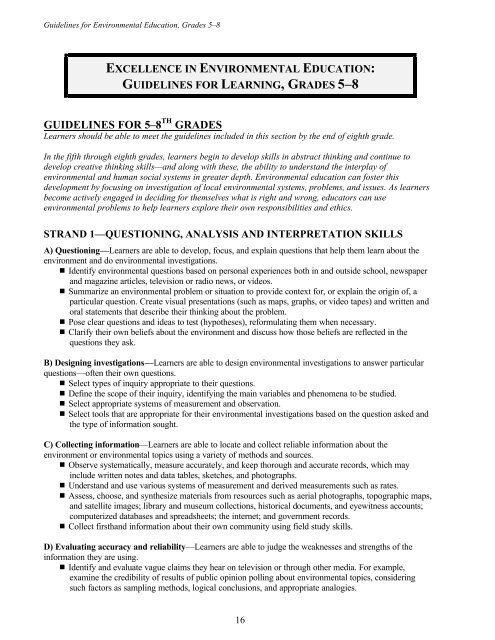
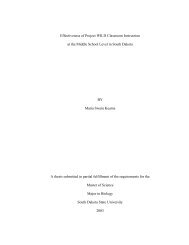
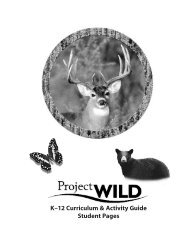
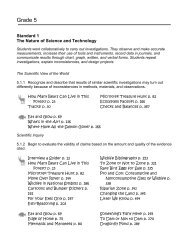
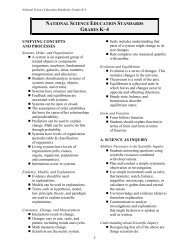
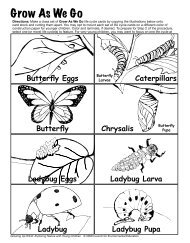
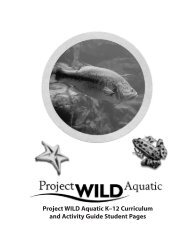
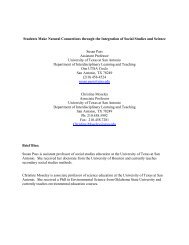
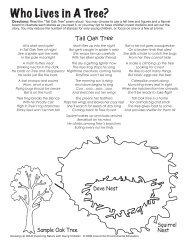
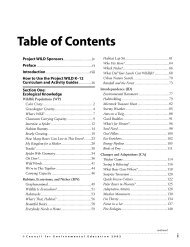
![Conceptual Framework [PDF] - Project Wild](https://img.yumpu.com/34019659/1/190x247/conceptual-framework-pdf-project-wild.jpg?quality=85)
